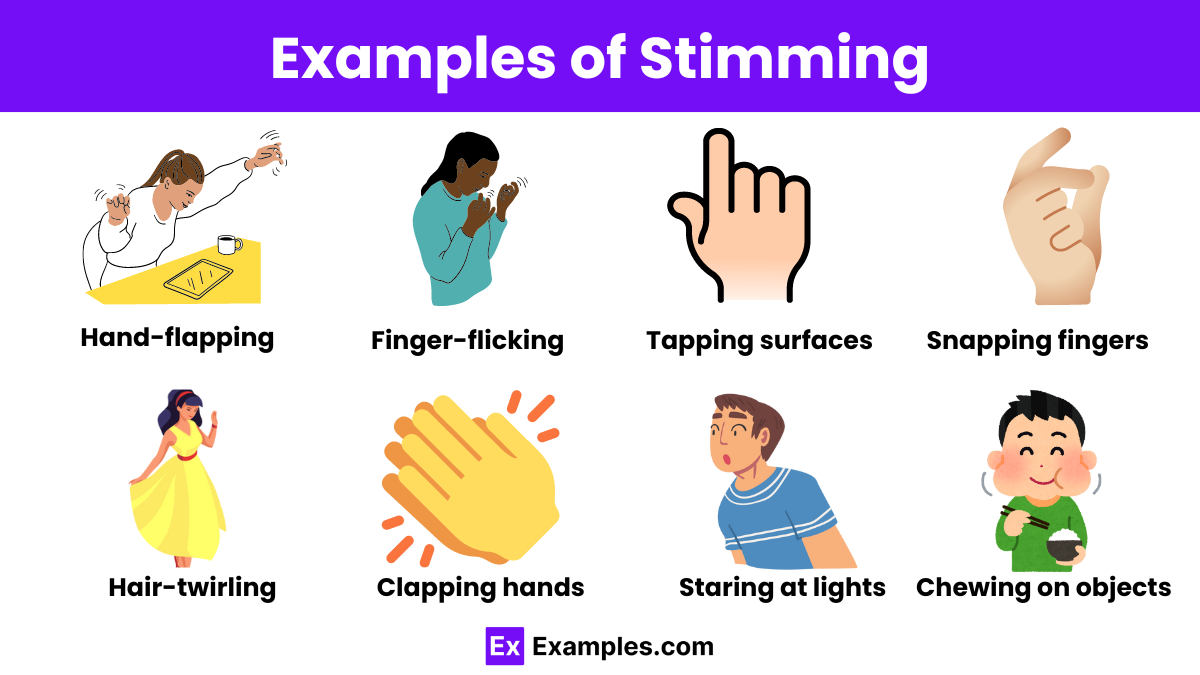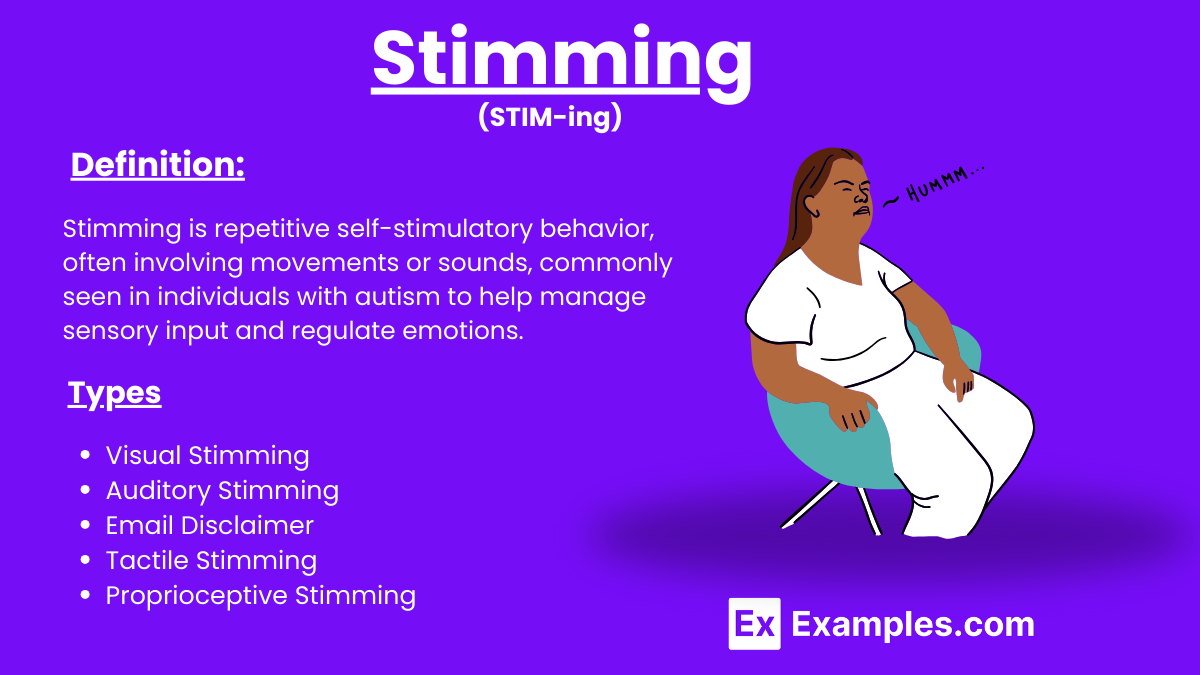Stimming
Stimming refers to self-stimulatory behavior, often seen in individuals with autism. These repetitive actions, such as hand-flapping or rocking, help regulate emotions and sensory input. Stimming can influence physiological responses, including breathing and heart rate, providing a sense of calm or focus. While often misunderstood, stimming is a natural coping mechanism that can improve concentration and emotional well-being. Understanding stimming’s role in managing stress and sensory overload is crucial for support and acceptance.
What Is Stimming?
Stimming is self-stimulatory behavior involving repetitive actions like hand-flapping, rocking, or humming. Common in individuals with autism, it helps regulate emotions and sensory input, providing comfort and focus. Stimming is a natural coping mechanism for managing stress and sensory overload.
Examples of Stimming

- Hand-flapping
- Rocking back and forth
- Spinning objects
- Finger-flicking
- Repeating phrases
- Humming
- Tapping surfaces
- Pacing
- Snapping fingers
- Lining up toys
- Hair-twirling
- Bouncing legs
- Clapping hands
- Rubbing hands together
- Staring at lights
- Repeating words
- Chewing on objects
- Drumming fingers
Types of Stimming in Autism
- Visual Stimming – Staring at lights or spinning objects, which helps process visual sensory input and provides comfort.
- Auditory Stimming – Repeating words or humming to regulate auditory input and create a soothing sound environment.
- Tactile Stimming – Rubbing hands or touching surfaces to manage tactile sensations and reduce anxiety.
- Vestibular Stimming – Rocking back and forth or spinning to balance sensory input related to movement.
- Proprioceptive Stimming – Bouncing or jumping to understand body position and improve spatial awareness.
- Olfactory Stimming – Sniffing objects or people to process smells and manage olfactory sensory input.
- Gustatory Stimming – Chewing on objects to experience different tastes and textures, calming sensory needs.
- Verbal Stimming – Repeating phrases or sounds to communicate feelings or relieve stress and anxiety.
Why is Neurodivergent Stimming Different?
Neurodivergent stimming differs because it serves as a vital coping mechanism for sensory processing and emotional regulation. Unlike typical fidgeting, neurodivergent stimming can profoundly impact breathing, heart rate, and even plasma cortisol levels, reducing stress and anxiety. This unique form of self-stimulation helps individuals manage sensory overload and maintain focus, highlighting the importance of understanding and accommodating these behaviors in neurodiverse populations.
Stimming Triggers
- Sensory Overload – Intense lights, loud noises, or strong smells can overwhelm and trigger stimming.
- Anxiety – High stress or anxiety levels can increase heart rate and lead to stimming as a calming mechanism.
- Excitement – Extreme joy or excitement may cause stimming as an outlet for excess energy.
- Frustration – Difficulty in communication or problem-solving can result in stimming to release frustration.
- Boredom – Lack of engagement or stimulation might trigger stimming to self-entertain.
- Fatigue – Being overly tired can increase the likelihood of stimming as a self-soothing behavior.
- Change in Routine – Unexpected changes or disruptions in routine can lead to stimming for comfort.
- Social Interaction – Challenging social situations can provoke stimming as a way to cope with discomfort.
Is Stimming Harmful?
Stimming is generally not harmful and serves as a coping mechanism for sensory regulation and emotional control. However, some forms of stimming, like head-banging or skin-picking, can cause physical harm, such as bruises or even bone injuries, and may need intervention. Understanding and supporting safe stimming practices is crucial for promoting well-being without causing injury.
How to Stop Stimming in Adults
- Identify Triggers – Observe and note situations or stimuli that trigger stimming behaviors to address the underlying cause.
- Create a Sensory-Friendly Environment – Modify surroundings to reduce sensory overload, such as dimming lights or minimizing noise.
- Develop Coping Strategies – Introduce alternative coping mechanisms like deep breathing exercises, meditation, or stress balls.
- Engage in Physical Activity – Regular exercise can help manage excess energy, reduce the need for stimming, and improve overall health by balancing gut bacteria.
- Seek Professional Support – Consult therapists or counselors specializing in sensory processing and behavior management for personalized strategies.
- Practice Mindfulness – Techniques like mindfulness and relaxation can increase awareness and control over stimming behaviors.
How to Manage Stimming?
- Incorporate Sensory Breaks – Schedule regular breaks during the day for sensory activities, like using a weighted blanket or listening to calming music.
- Use Visual Supports – Implement visual schedules or social stories to help individuals understand and manage their stimming behaviors.
- Encourage Hobbies – Promote engaging activities like drawing, painting, or playing musical instruments that can channel energy in a positive way, similar to how renewable resources provide sustainable energy
- Implement Occupational Therapy – Work with an occupational therapist to develop personalized sensory diets and strategies tailored to individual needs.
- Utilize Biofeedback – Use biofeedback techniques to help individuals become more aware of their physiological responses and learn to control them.
- Create a Safe Stimming Space – Designate a specific area at home or work where individuals can stim freely and safely without judgment or interruption.
Reasons for Stimming
- Sensory Regulation – Helps manage sensory input, reducing overload or seeking additional stimulation.
- Emotional Expression – Expresses emotions such as excitement, anxiety, or frustration.
- Comfort and Self-Soothing – Provides a sense of comfort and calm, particularly in stressful situations.
- Focus and Concentration – Aids in maintaining focus during tasks or while processing information.
- Routine and Predictability – Offers a sense of routine and predictability, especially in unfamiliar or chaotic environments.
- Communication – Serves as a non-verbal way to communicate needs or feelings when verbal expression is difficult.
- Physical Relief – Releases built-up physical tension or excess energy.
- Enjoyment – Engages in stimming behaviors because they are inherently enjoyable or satisfying, similar to how creatures interact within their ecology.
Benefits of Stimming
- Self-Regulation: Helps individuals manage overwhelming emotions or sensory input, providing a calming effect.
- Focus and Concentration: Assists in maintaining attention and focus, particularly in challenging or stimulating environments.
- Expression: Provides a way for individuals to express emotions or needs when verbal communication may be difficult.
- Sensory Integration: Aids in processing and organizing sensory information, making it easier to cope with sensory overload.
- Comfort: Offers a sense of comfort and security, especially in unfamiliar or stressful situations.
- Emotional Release: Allows for the release of pent-up energy or stress, contributing to overall emotional well-being.
Who typically engages in stimming?
Stimming is common in individuals with autism but can also occur in neurotypical people.
Is stimming always a sign of autism?
No, stimming can occur in anyone, though it is more frequent and varied in autistic individuals.
Why do people stim?
People stim to manage sensory input, express emotions, and cope with stress.
Can stimming be harmful?
Stimming is generally harmless but can be harmful if it involves self-injury like head-banging.
How can you reduce harmful stimming?
Reduce harmful stimming by identifying triggers and offering safer alternatives.
Is it possible to stop stimming completely?
It’s challenging and often unnecessary to stop stimming completely, as it serves important functions.
Should stimming always be stopped?
No, harmless stimming should be accepted as it helps with self-regulation and emotional control.
Can stimming be a positive behavior?
Yes, stimming can be positive by helping individuals focus and reduce stress.
What triggers stimming?
Triggers include sensory overload, anxiety, excitement, frustration, and changes in routine.
How can stimming be managed in adults?
Manage stimming in adults by creating a sensory-friendly environment and developing alternative coping strategies.



